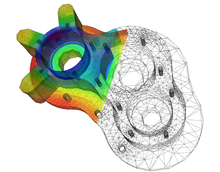Computational engineering

Computational Engineering is an emerging discipline that deals with the development and application of computational models for engineering, known as Computational Engineering Models[1] or CEM. Computational engineering uses computers to solve engineering design problems important to a variety of industries.[2] At this time, various different approaches are summarized under the term Computational Engineering, including using computational geometry and virtual design for engineering tasks,[3][4] often coupled with a simulation-driven approach[5] In Computational Engineering, algorithms solve mathematical and logical models[6] that describe engineering challenges, sometimes coupled with some aspect of AI, specifically Reinforcement Learning.[7]
In Computational Engineering the engineer encodes their knowledge using logical structuring. The result is an algorithm, the Computational Engineering Model, that can produce many different variants of engineering designs, based on varied input requirements. The results can then be analyzed through additional mathematical models to create algorithmic feedback loops.[8]
In Computational Engineering, computer simulation provides the capability to create feedback that would be inaccessible to traditional experimentation or where carrying out traditional empirical inquiries is prohibitively expensive.
Computational Engineering should neither be confused with pure computer science, nor with computer engineering,[10] although a wide domain in the former is used in Computational Engineering (e.g., certain algorithms, data structures, parallel programming, high performance computing) and some problems in the latter can be modeled and solved with Computational Engineering methods (as an application area).
It is typically offered as a masters or doctorate program.[11]
Methods
Computational Engineering methods and frameworks include:
- High performance computingand techniques to gain efficiency (through change in computer architecture, parallel algorithms etc.)
- Modeling and simulation
- Algorithmsfor solving discrete and continuous problems
- Analysis and visualization of data
- Mathematical foundations: Numerical and applied linear algebra, initial & boundary value problems, Fourier analysis, optimization
- Data Science for developing methods and algorithms to handle and extract knowledge from large scientific data
With regard to computing, computer programming, algorithms, and
Open Source Movement
There are a number of Free and Open-Source Software (FOSS) tools that support Computational Engineering.
- OpenSCAD was released in 2010 and allows the scripted generation of CAD models, which can form the basis for Computational Engineering Models.
- CadQuery uses Python to generate CAD models and is based on the OpenSCAD framework. It is released under the Apache 2.0 Open-Source License.
- PicoGKis an open-source framework for Computational Engineering which was released under the Apache 2.0 Open-Source License in 2023 by LEAP 71, a Dubai-based company.[13]
Applications

Computational Engineering finds diverse applications, including in:
- Mechanical Engineering: combustion simulations, structural dynamics, computational fluid dynamics, computational thermodynamics, computational solid mechanics, vehicle crash simulation, biomechanics, trajectory calculation of satellites
- Astrophysical systems
- Battlefield simulations and military gaming, homeland security, emergency response
- Biology and Medicine: protein folding simulations (and other macromolecules), bioinformatics, genomics, computational neurological modeling, modeling of biological systems (e.g., ecological systems), 3D CT ultrasound, MRI imaging, molecular bionetworks, cancer and seizure control
- Chemistry: calculating the structures and properties of chemical compounds/molecules and solids, computational chemistry/cheminformatics, molecular mechanics simulations, computational chemical methods in solid state physics, chemical pollution transport
- finite element analysis, structures with random loads, construction engineering, water supply systems, transportation/vehicle modeling
- Electrical Engineering, and Telecommunications: VLSI, computational electromagnetics, semiconductor modeling, simulation of microelectronics, energy infrastructure, RF simulation, networks
- Epidemiology: influenza spread
- climate research, Computational geophysics(seismic processing), modeling of natural disasters
- Finance: derivative pricing, risk management
- Industrial Engineering: discrete event and Monte-Carlo simulations (for logistics and manufacturing systems for example), queueing networks, mathematical optimization
- Material Science: glass manufacturing, polymers, and crystals
- Nuclear Engineering: nuclear reactor modeling, radiation shielding simulations, fusion simulations
- Petroleum engineering: petroleum reservoir modeling, oil and gas exploration
- Physics: Computational particle physics, automatic calculation of particle interaction or decay, plasma modeling, cosmological simulations
- Transportation
See also
- Modeling and simulation
- Applied mathematics
- Computational science
- Computational mathematics
- Computational fluid dynamics
- Computational electromagnetics
- High-performance computing
- Engineering mathematics
- Grand Challenges
- Numerical analysis
- Multiphysics
References
- ^ "Computational Engineering Models for the Design of Mechanical Counterpressure Spacesuits". 2022-12-21. Archived from the original on 2022-12-21. Retrieved 2023-06-27.
- ^ "What is Computational Engineering?". www.ae.utexas.edu. Retrieved 2023-09-20.
- ^ "Research Area: Computational Engineering | Mechanical Engineering". me.stanford.edu. Retrieved 2023-04-22.
- ^ "Computational engineering". www.meche.engineering.cmu.edu. Retrieved 2023-04-22.
- ^ "Research Area: Computational Engineering | Mechanical Engineering". me.stanford.edu. Retrieved 2023-02-27.
- ^ Editorial Staff (2021-12-24). "What is Computational Engineering? • College Guidepost". College Guidepost. Retrieved 2023-04-22.
- ^ "What Is Computational Engineering?".
- ^ Editorial Staff (2021-12-24). "What is Computational Engineering? • College Guidepost". College Guidepost. Retrieved 2023-04-22.
- ^ "Computational Science and Engineering Program: Graduate Student Handbook" (PDF). cseprograms.gatech.edu. September 2009. Archived from the original (PDF) on 2014-10-14. Retrieved 2012-04-08.
- ^ "What is Computational Engineering?". www.ae.utexas.edu. Retrieved 2023-09-20.
- ^ "Graduate and Undergraduate Programs in Computational Science". SIAM. Retrieved 2020-05-23.
- ^ "Why is fortran extensively used in scientific computing and not any other language?". ResearchGate. Retrieved 2020-05-23.
- ^ "About PicoGK | LEAP 71". leap71.com. Retrieved 2023-11-20.
External links
- Oden Institute for Computational Engineering and Sciences
- Scope of Computational engineering
- Society of Industrial and Applied Mathematics
- International Centre for Computational Engineering (IC2E)
- Georgia Institute of Technology, USA, MS/PhD Programme Computational Science & Engineering
- The graduate program for the University of Tennessee at Chattanooga
- Master and PhD Program in Computational Modeling at Rio de Janeiro State University
- Computational Science and Engineering with Scilab
- Internacional Center for Numerical Methods in Engineering (CIMNE)
